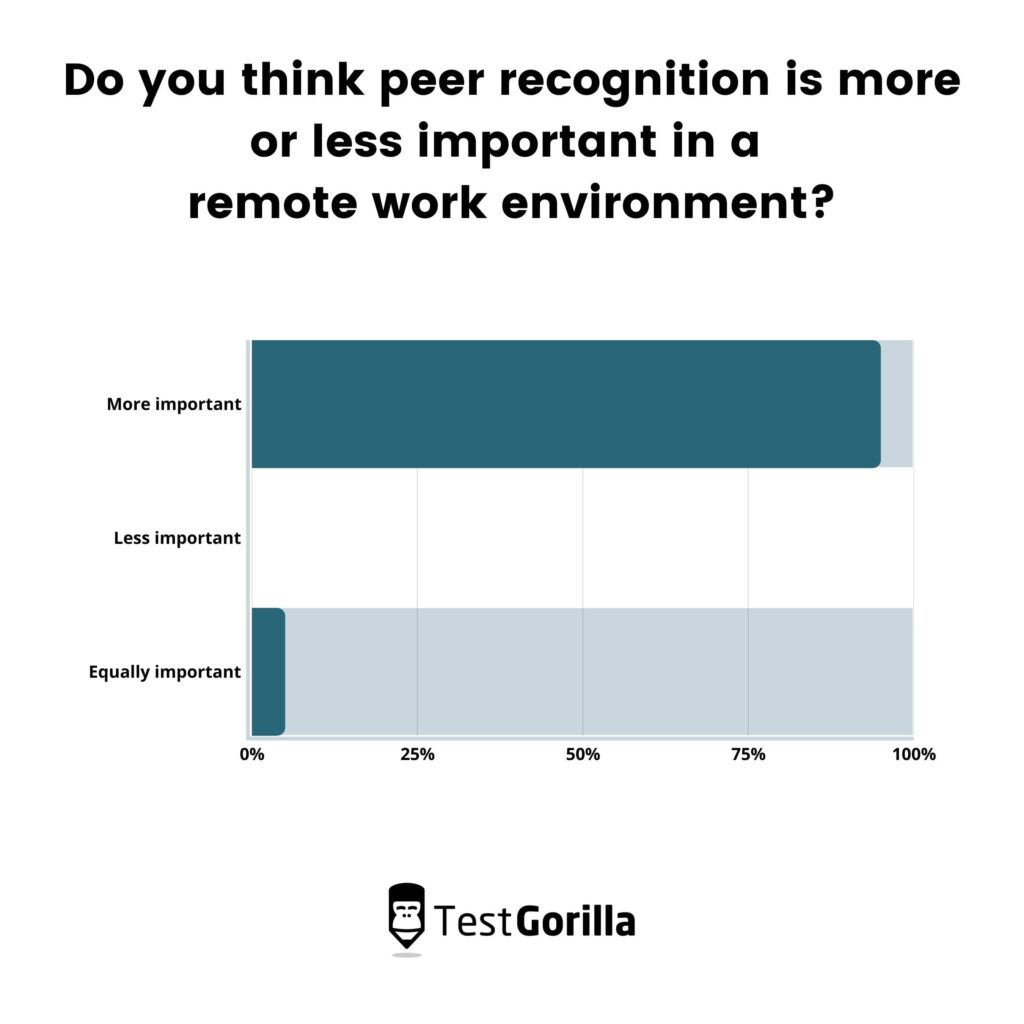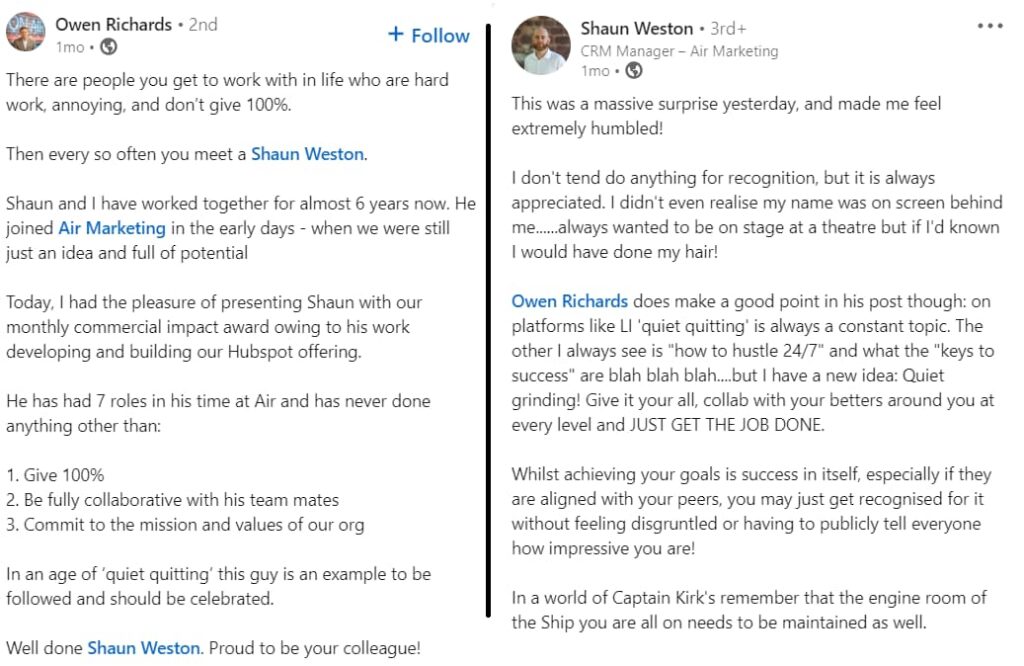Julia is a sales rep who has been making excellent progress at a new company.
She communicates well, hits her sales targets, and completes her work before the deadline.
Julia knows her work is solid, but she isn’t sure whether her coworkers notice.
So when her peers Mark and Alex each send her a message acknowledging her skill and effort, it gives Julia a major morale boost.
Peer to peer recognition like this boosts motivation, performance, and engagement and nurtures work relationships with teammates and company alike – which increases cooperation during group projects.
So how can HR professionals encourage this behavior and build a healthy environment for peer to peer recognition?
In this article, we discuss what peer to peer recognition is and why it’s effective, why it’s an important factor in organizational health, and the eight best practices you can adopt to facilitate it in your company.
Table of contents
What is peer to peer recognition?
Peer-to-peer recognition is the act of one employee recognizing another employee’s work, accomplishments, or deliverables.
A few peer-to-peer recognition examples include:
Positive private messages
Kudos during team meetings
Social recognition on platforms like LinkedIn
Solid relationships with your peers are essential for a positive workplace environment and recognition is an excellent way to build them.
Why does peer to peer recognition work?
It isn’t just random chance that peer-to-peer recognition works. Several psychological factors make it such a powerful form of acknowledgment.
According to Harvard Business Review, peer-to-peer recognition works much the same as peer-to-peer coaching. Here are a few reasons why it works:
You get insights from a diverse range of perspectives: When you get recognition from your peers, you aren’t getting acknowledgment from the same person each time but from different members of the group. This gives you a wider range of experiences and opinions.
Many employees feel safer and more comfortable around peers: Getting recognition from those you feel comfortable and safe around feels rewarding. Workers expect senior leaders to offer certain praise, but when it comes from their peers, it feels sincere and warm.
Another factor is the personal touch. Peers have similar work experience, goals, and difficulties, so there’s a great sense of connection when coworkers say you’ve done well.
This type of recognition also works because it supplements areas where praise and kudos are lacking.
For instance, 67% of managers think they’re above average in offering praise and recognition, but only 23% of their employees agree. The extra support from peers helps bridge this gap.
Leaders often have a lot on their plates, so if recognition is left solely to them, a lot of great work can go unnoticed.
Peer recognition also benefits whoever is on the giving side of the praise. It enables employees to make a positive impact in their workplace that they can really see and gives them a sense of agency and control. They can truly feel that something great is in their hands.
Why is peer to peer recognition important in the workplace?
It’s easy enough to say that a peer-to-peer recognition program adds to employee happiness, but the effects extend far deeper than that.
Peer-to-peer recognition builds a strong, healthy team atmosphere. It fosters a deeper connection and more empathy and helps create a better workplace.
Let’s look at the benefits of peer-to-peer recognition in detail:
Benefit | Description |
1. Helps create a more collaborative work environment | Strong relationships with teammates lead to better, easier |
2. Promotes positive values and helps curb toxic behaviors | A positive environment fosters positive company values like openness and communication; The probability of a constructive organizational culture with regular peer-to-peer recognition |
3. Leads to better inclusivity | Employees recognizing each other’s unique skills improves overall inclusivity |
4. Fosters a higher level of trust between teams | Knowing your teammates recognize your achievements strengthens your bonds with the your own and other teams in the company |
5. Improves team morale | A team in which employees encourage each other is more confident and driven |
6. Increases performance | Workers who feel appreciated go that extra mile and tend to produce higher-quality workPeer feedback can improve |
7. Leads to higher motivation and engagement | Employees who receive peer praise are motivated to try their best and feel a strong connection to their work |
8. Lowers turnover and absenteeism | Lack of recognition is a leading cause of high employee turnover; The more channels of acknowledgment, the better the workplace environment will be |
Overall, peer-to-peer recognition builds a strong, healthy team atmosphere. This connection fosters a deeper connection and more empathy.
It also nurtures a culture of gratitude and positivity. Showing appreciation for peers benefits the giver and the receiver, building an environment where giving kudos and support becomes a natural behavior.
This is exactly the type of workplace culture that current and potential employees look for. In fact, a strong company culture is one of the top job satisfaction factors, according to Glassdoor.
8 peer to peer recognition best practices
In this section, we’ll go over some peer-to-peer recognition ideas and best practices to help you build a strong company culture.
Employee appreciation is one of our top incentives for employees, but how do you put it into practice?
Here’s a quick summary of the best practices to adopt:
Strategy | Description |
1. Use an employee recognition platform | Adopt employee recognition software to make peer recognition quick and simple |
2. Gamify the recognition process | Implement rewards and points to encourage regular peer praise |
3. Include peer-to-peer recognition in your formal performance review process | Add peer reviews to your formal review process for a diverse range of perspectives |
4. Add a moment for peer-to-peer recognition to your weekly huddle | Encourage and motivate teammates by celebrating their achievements during weekly meetings |
5. Foster inclusivity by recognizing the accomplishments of all team members | Ensure every worker is celebrated, even new hires and remote employees |
6. Give employees the opportunity to get public recognition | Enable employees to share successes on public platforms like LinkedIn |
7. Foster a culture of frequent, immediate recognition | Recognition is more effective the closer it happens to the event |
8. Make sure management leads by example and trains employees | Lead from the top and nurture a culture of peer recognition by doing it yourself |
Now let’s talk about them in-depth.
1. Use an employee recognition platform (especially for remote workers)
An employee recognition platform is software that makes it easier to celebrate employee accomplishments and achievements.
Such systems provide a central location to give and receive recognition, which not only makes it quick and simple to praise skill and achievement but also to celebrate important milestones like:
Birthdays
Work anniversaries
Successful projects
Promotions or role changes
At TestGorilla, we use HiBob as our peer recognition platform. Features like “kudos” enable quick, simple, and effective peer-to-peer recognition.
It has a Slack integration, too, so you can flag birthdays and work anniversaries.
We also use our employee recognition platform to recognize the workers who sometimes slip through the cracks – remote workers.
Since remote workers aren’t always visible during your work day, their efforts can sometimes go unnoticed.
A study by Nectar HR showed that 95% of workers believe it’s more important to recognize remote peers than in-person ones.
It’s easy to forget about remote workers’ accomplishments, but they crave recognition like everyone else.
A virtual recognition board, such as a channel on Slack, is a great way to ensure your remote employees stay engaged, motivated, and appreciated.
2. Gamify the recognition process
Gamification is turning an activity into a game by using points, rewards, and other interactivity elements.
It boosts employee engagement and excitement, and companies are using it for learning, training, referrals, and, yes, even recognition.
Peer-to-peer recognition can be encouraged in your company by adding a game element. Examples include:
A points-based system
A coworker of the month program
Prizes and rewards employees can assign alongside their recognition
MRI Software uses gamified peer recognition where employees gift each other “Kazoo points,” which they can redeem for prizes. Simon Reynolds, account director at MRI, used his Kazoo points to buy a watch.
Gamifying peer recognition encourages and incentivizes employees to praise each other. This helps build recognition into your company culture, so it becomes second nature to your team after a while.
3. Include peer to peer recognition in your formal performance review process
Peer reviews can be an invaluable part of your performance review process. Some people even believe they’re the future of performance reviews.
This means that your performance reviews aren’t handled once a year by a single manager; rather, reviews are given multiple times a year by both senior leadership and peers.
Peer recognition in performance reviews helps capture multiple opinions and diverse perspectives. It also gives the employee a review from a colleague they may work personally with.
At TestGorilla, we conduct a two-month review for new starters and those who changed roles or received promotions.
Companies like Google and Netflix also use peer reviews in their performance review process.
Generally, senior leadership gathers feedback and recognition from colleagues and delivers it for them, either anonymously or not, depending on the review structure.
A good practice is to gather three to four bits of feedback every few weeks or at the end of a significant project milestone.
This process enables peers to give a diverse variety of praise because they can provide senior leadership with somewhat obscure bits of recognition that may not be visible to others.
4. Add a moment for peer to peer recognition to your weekly huddle
A weekly huddle gets your team’s thoughts together, motivates them, and gets them started for a week of hard work.
What’s a better time to praise a colleague to really jumpstart their week?
Encouraging peer-to-peer recognition and kudos during meetings is more than a private pat on the back. It provides an opportunity to involve multiple colleagues or incite group applause.
This means it’s also a way for other employees to learn good habits, skills, and behaviors.
It’s a good practice to set aside a few minutes specifically for recognition so it doesn’t cut into the meeting’s agenda.
Our team here at TestGorilla allots 10 minutes in our company-wide standups each week. We encourage folks to do shout-outs across the whole organization.
Recognition in this form typically celebrates larger achievements, like work milestones or the completion of a significant project. But if a team member wants to give kudos for a smaller win – more power to them!
5. Foster inclusivity by recognizing the accomplishments of all team members
Inclusive recognition is key to creating a healthy work culture.
All members of the team crave – and deserve – praise for their accomplishments. This means you should encourage your team to recognize wins wherever they can to avoid showing favoritism.
Some groups slip under the radar of recognition, such as:
New hires
Workers under a flexible working policy
Roles out of the limelight, such as IT professionals
For example, it’s second nature to tell a high-performer of five years that they’re doing well, but it might not be as obvious to tell the new hire how well they’re adjusting.
Peer-to-peer recognition can boost employee morale, especially for new hires. Simply recognizing a few small victories encourages new joiners and helps them adapt and grow.
Encouraging group acknowledgment is one way to boost inclusivity and ensure key workers aren’t left out.
CIPR, a public relations company, awards Fellowships to its employees to award dedication and professionalism. This is a system where employees nominate each other and then seven workers are granted a Fellow status within the company.
Group acknowledgment is a surefire way to boost inclusivity. It enables employees to praise and recognize multiple coworkers at once and can be used to acknowledge remote teams, recent hires, or under-appreciated teams.
6. Give employees the opportunity to get public recognition
Public recognition, where an employee states their peer’s accomplishments loud and proud, is another form of acknowledgement that is highly motivating and empowering.
Many employees are excited to see their achievements publicly touted by a teammate they respect. It brings their accomplishments to the forefront of others’ minds – and improves teamwork.
You can facilitate this practice by encouraging posts on social media platforms like LinkedIn or across the company intranet.
Take a look at this exchange between Owen Richards and Shaun Weston, two employees from Air Marketing:
Owen surprised Shaun with an unprompted post detailing his commitment, collaboration, and hard work. As you can see, this act thrilled and humbled Shaun.
Pro tip: LinkedIn endorsements are a subtle way to show you appreciate your colleague’s skills.
However, it’s important to be mindful of the employee you’re recognizing. If an employee is very introverted and reserved, a public acknowledgment may shock or even upset them, so try another route.
Encourage your employees to acknowledge personal preferences and respect them. Introverted teammates still desire recognition but may vastly prefer when it’s done in private.
7. Foster a culture of frequent, immediate recognition
People want recognition when it’s recent and relevant.
One of the biggest flaws of annual performance reviews is how distant the feedback is from the act itself.
Immediate employee recognition boosts motivation and tells an employee they’re doing something right so they can continue to do it.
For example, when you tell Brian that his sales call with Prospect B was excellent because he did XYZ, Brian will see the value of his XYZ skills. That way, he can focus his efforts on improving them to continue this trend.
Immediate recognition benefits those who are neurodivergent, too, as their brains separate rewards from causes if they’re too far apart.
This is called “reward delay” or “Reward Deficiency Syndrome.”
The more you recognize the achievements of others the moment they happen, the more the employee you praised learns to nurture their good habits.
An employee recognition platform facilitates this culture. This enables employees to fire off a quick kudos the moment it’s in their minds.
8. Make sure leadership leads by example and trains employees on how to give recognition
Leading from the top encourages a variety of good behaviors, and peer recognition is one of them.
If you want to integrate anything into your company culture, leading by example is the easiest way to do so. After all, only so many of your people will practice what you preach if your leaders’ actions don’t back it up.
Here are a few ways senior leadership can encourage peer-to-peer recognition:
Recognize and celebrate team success
Take pride in their employee’s good work
Give out kudos during the weekly huddle
Offer coaching and advice during 1:1 meetings
The last one is especially important. Specifically training your employees on how to give peer-to-peer recognition via coaching and mentoring spreads the practice even further.
Train your people on when, where, and how to give recognition. You can coach anyone, but it’s vital to coach your middle and frontline managers so they can, in turn, coach their teams.
A reliable team is built on peer to peer recognition
Peer-to-peer recognition is a powerful tool that motivates and engages employees.
Try leading from the top by adding a few of these best practices into your processes, like doing shout-outs during your weekly huddle or giving kudos on your group chat. You’ll soon see the effects of your efforts trickling down to others.
When you build peer recognition into your culture, you naturally encourage your employees to lift each other up, celebrate achievements, and make everyone feel important.
For more reading on company culture, read our article on assessing your company’s organizational culture.
To learn more about your employees and how likely they are to give recognition, add our Enneagram test to your next skills assessment.
Related posts
Hire the best candidates with TestGorilla
Create pre-employment assessments in minutes to screen candidates, save time, and hire the best talent.
Latest posts
The best advice in pre-employment testing, in your inbox.
No spam. Unsubscribe at any time.

Hire the best. No bias. No stress.
Our screening tests identify the best candidates and make your hiring decisions faster, easier, and bias-free.
Free resources
This checklist covers key features you should look for when choosing a skills testing platform
This resource will help you develop an onboarding checklist for new hires.
How to assess your candidates' attention to detail.
Learn how to get human resources certified through HRCI or SHRM.
Learn how you can improve the level of talent at your company.
Learn how CapitalT reduced hiring bias with online skills assessments.
Learn how to make the resume process more efficient and more effective.
Improve your hiring strategy with these 7 critical recruitment metrics.
Learn how Sukhi decreased time spent reviewing resumes by 83%!
Hire more efficiently with these hacks that 99% of recruiters aren't using.
Make a business case for diversity and inclusion initiatives with this data.
























